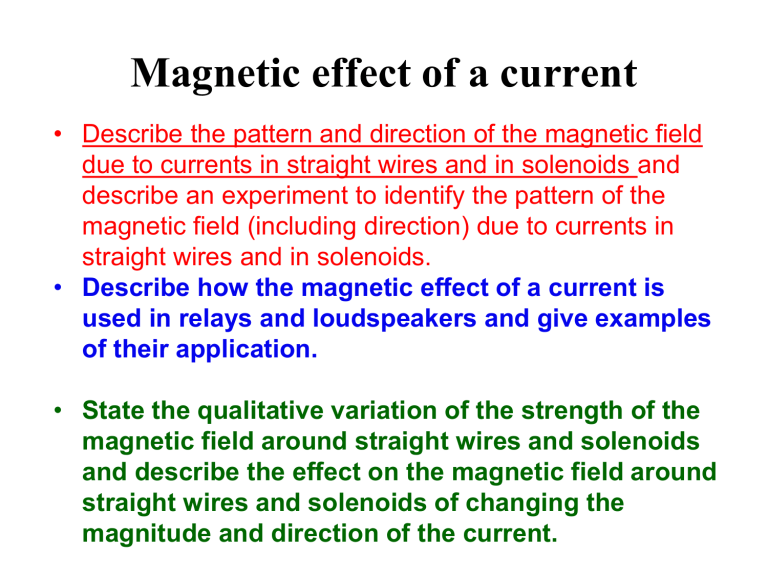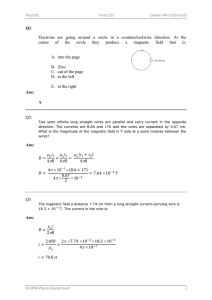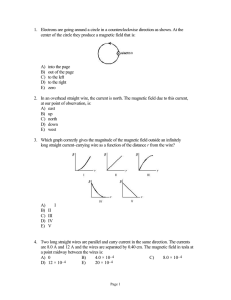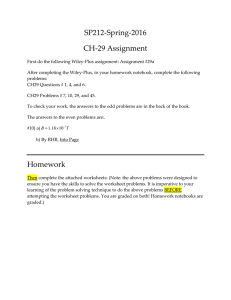
Magnetic effect of a current • Describe the pattern and direction of the magnetic field due to currents in straight wires and in solenoids and describe an experiment to identify the pattern of the magnetic field (including direction) due to currents in straight wires and in solenoids. • Describe how the magnetic effect of a current is used in relays and loudspeakers and give examples of their application. • State the qualitative variation of the strength of the magnetic field around straight wires and solenoids and describe the effect on the magnetic field around straight wires and solenoids of changing the magnitude and direction of the current. No current, compass points to north In 1820 Hans Ørsted noticed that a wire carrying an electric current caused a compass needle to deflect. Current, compass deflected https://youtu.be/2bMSHVF30C4 Describe the pattern and direction of the magnetic field due to currents in straight wires and in solenoids and describe an experiment to identify the pattern of the magnetic field (including direction) due to currents in straight wires and in solenoids. Magnetic field patterns around wires 1. Straight wire The magnetic field consists of concentric circles centred on the wire. The magnetic field is strongest near the wire. This is shown by the field lines being closest together near to the wire. Describe the pattern and direction of the magnetic field due to currents in straight wires and in solenoids and describe an experiment to identify the pattern of the magnetic field (including direction) due to currents in straight wires and in solenoids. The right-hand grip rule (for fields) Grip the wire with the RIGHT hand. The thumb is placed in the direction of the electric current. The fingers show the direction of the circular magnetic field. More magnetic field patterns 5 of 43 © Boardworks Ltd 2012 Complete the diagrams below: Add field arrows Add current direction Add current direction Add field arrows Electric current out of the page Electric current into the page Describe the pattern and direction of the magnetic field due to currents in straight wires and in solenoids and describe an experiment to identify the pattern of the magnetic field (including direction) due to currents in straight wires and in solenoids. 2. Flat circular coil Plan view Describe the pattern and direction of the magnetic field due to currents in straight wires and in solenoids and describe an experiment to identify the pattern of the magnetic field (including direction) due to currents in straight wires and in solenoids. 3. Solenoid A solenoid is a coil of wire carrying an electric current. The magnetic field is similar in shape to that around a bar magnet. N S The strength of the field increases with: 1. the electric current 2. the number of turns in the coil Describe the pattern and direction of the magnetic field due to currents in straight wires and in solenoids and describe an experiment to identify the pattern of the magnetic field (including direction) due to currents in straight wires and in solenoids. The right-hand grip rule (for poles) Grip the coil with the RIGHT hand. The fingers are placed in the direction that the eclectic current flows around the coil. The thumb points towards the north pole end of the coil. Describe the pattern and direction of the magnetic field due to currents in straight wires and in solenoids and describe an experiment to identify the pattern of the magnetic field (including direction) due to currents in straight wires and in solenoids. Complete the diagrams below: 1. Locate north 2. Locate south 3. Add current direction S N 4. Add coils N Describe the pattern and direction of the magnetic field due to currents in straight wires and in solenoids and describe an experiment to identify the pattern of the magnetic field (including direction) due to currents in straight wires and in solenoids. 1. The relay switch switch A A relay switch is a way of using a low voltage circuit to switch remotely a high voltage (and possibly dangerous) circuit. iron armature When switch A is closed, the small current provided by the cell causes the electromagnet to become magnetised.. electromagnet The iron armature is then attracted to the electromagnet causing the springy contact switch B to close in the high voltage circuit. hinge springy contact switch B to high voltage circuit Describe how the magnetic effect of a current is used in relays and loudspeakers and give examples of their application. 2. The loudspeaker The sound signal consists of an alternating current supplied by the amplifier. This current flows through the coil of the loudspeaker. Due to the motor effect, the magnetic field around the coil causes the coil to vibrate in step with the alternating current. The coil causes the diaphragm (speaker cone) to vibrate in step with the original sound signal. The diaphragm causes air to vibrate and so produces a sound wave. •https://youtu.be/RxdFP31QYAg Describe how the magnetic effect of a current is used in relays and loudspeakers and give examples of their application. Variation of Magnetic field patterns around wires. The strength of the field increases if the electric current is increased. Changing the direction of current changes the direction of the magnetic field. State the qualitative variation of the strength of the magnetic field around straight wires and solenoids and describe the effect on the magnetic field around straight wires and solenoids of changing the magnitude and direction of the current. Variation of Magnetic field patterns around Solenoid The strength of the field increases with: 1. the electric current 2. the number of turns in the coil N Changing the direction of the current changes the poles State the qualitative variation of the strength of the magnetic field around straight wires and solenoids and describe the effect on the magnetic field around straight wires and solenoids of changing the magnitude and direction of the current. S








